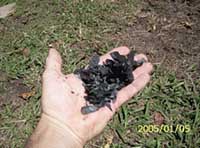Biochar
Quick links:
- Biochar Workshop: Hands on Education Camp
- Making Agricultural Charcoal at Home - Download as .rtf or Download as .doc
- Low Cost Low Emission, Charcoal Kiln and Retorts - Download as .rtf or Download as .doc
- Download PowerPoint for NE Biochar Conference (5.1mb)
- Making Biochar on the farm page.
- Become an International Biochar Initiative Charter MemberHi Charriers,
I have recently returned from the Watermark hotel in Surfer's Paradise, venue for the International Biochar Initiative's S E Asia Conference, where some 64 papers were presented. I had an intense but wonderful time.
I certainly enjoyed meeting up with school friend Stephen Joseph again after 41 years, and I found a few other old friends there too, including Alan Coates from the Channon.
What I thought was the most significant connection there was Engineers Without Borders. They have connected now with HATCH, a non-profit consulting group in Brisbane, and coined the name OpenChar:
" ... with the primary focus of profit potential put to one side, the extraordinary potential of of biomass pyrolysis, and biochar application to soils will be unleashed." They will exist as an open-source website as soon as they customise the framework that EWB uses for their site, and will network volunteers and engineers to solve problems and finesse pyrolysers as a project for social development. That's a very good fit to Project 540. Exact, I'd say.
We talked with a very sparky Lizzie Brown from EWB, who is equally excited about the synergy with us and wants to send some young engineers down for work days, as soon as they can work it out and we can get things ready for them. How good does it get?
Apart from them, no one else is looking at small kilns, the smallest portable trailer unit being `$2million. We certainly got a lot of interest and thanks, and great response to our team-teaching oral presentation. With Paul Taylor talking philosophically, and me waving the non-contact pyrometer and thermocouple around, and talking cheap instrumentation and kiln structure, we created a good bit of interest, and general mirth, as I closed with "He's the scientist and I'm the mad scientist."
In "Skeptic's Question-time Game" Paul Taylor did a fantastic job of presenting the need for intellectual honesty when looking at the track record of the greed paradigm's way of displacing rightful land-use. I
got in a question on Peakoil and how to achieve all this in Catabolic Collapse, using Tim Flannery's charcoal powered tractors.... some nervous laughs, and deflection of the questions. MANY people came up and confirmed their agreement with our alignment, and thanked us.
[I will try to do a more detailed referenced account online soon,] but here are some teasers of 64 presentations, which I would have to say, unequivocally supported each other under an umbrella of clapboard, rigorous scientific investigation, proceeding at a fearsome pace.
Some choice findings were:
1. A characterisation technique has emerged using magnetic resonance spectroscopy, and Scanning Electron Microscope microprobes, that will lead to a positive ID of TP qualities, from say Hydrochar (Max Planck Inst), which appears to be great for C sequestration and poor as biochar.2. The same techniques have been applied to "Terra Preta Australis", found in cooking pit-mounds in Victoria, which matched the Amazonian twin peak aromatic peak profile. These TPA soils were radiocarbon dated, at 600 - 1300 years, with C still clearly present at large percentages.
3. Nikolaus Foidl in Brazil has got 15 cobs to a corn plant, 250% increase in maize yields, and 32cm sunflower heads with windrow-burned Terrapreta, including torrefied wood, which was colonised by small applications of salycylic acid* in the biochar to stimulate hyphae growth (*a natural plant hormone in eg willow bark).
4. Tsuyosi Hirokawa, a Japanese organic farmer of 25 years found his chickens 'dead' with coccidiosis, and threw his biochar on them in grief and frustration... and the next day they revived. An unintentionally hilarious presentation, which won the best award: "no, no... don't laugh... not funny, really happened.."
At 28 days he now deliberately induces the disease and then fasts them, and feeds 100% char day one, then 75%, 50%, and then 1% continuously thereafter. His eggs are now premium at 250% x current price. Feeding a charcoal ration to cows, and pigs and 'hoomans' also works...no, no not funny true.5. Makoto Ogawa, a Japanese professor presented conclusive results, in pictures, of tree doctoring some sacred pines with Dieback, by using a ring-trench filled with biochar at the drip line, inoculated with azobacter, which then stay sequestered, as well as the Carbon.
6. Evelyn Krull showed extraordinary results of ratios of char in estuary sands at Fitzroy as high as 50%. leading to a huge discussion about the extent to which the regime of top burning without incorporating into the soil has steadily sequestered our biomass hard C onto the continental shelf.
7. DPI Wollongbar showing results (peer reviewed) of 90 - 97% N2O sequestration (280 x CO2 equiv.) in the field trials. Different oral, but same results from Lincoln University NZ, and same again from DPI Pennant Hills with incubation trials. I asked Josh Rust why this utterly ground-breaking ag news didn't have a press gaggle after it. He's a bit puzzled too. It's huge news.
8. dept ag WA found decreased need for fertiliser in wheat crops with biochar.
9. NNSW cane farmer Robert Quirk found the same for his cane and is doing a nil fert crop next year.


